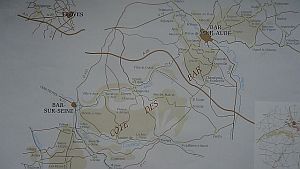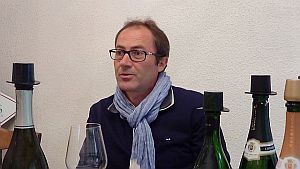 There’s something about Jean-Paul Hébrart that immediately puts you at ease. He comes across as serene and unruffled, well prepared and calm; the same could be said for his champagnes.
There’s something about Jean-Paul Hébrart that immediately puts you at ease. He comes across as serene and unruffled, well prepared and calm; the same could be said for his champagnes.
The Marc Hébrart range is not large, neither the labels nor the wines themselves are what you’d call flamboyant, but when you discover the smoothness on the tongue and the perfect seamlessness from first sip to the very long, lingering finish you’ll find it hard not to smile with a sense of pure satisfaction. They leave you with a sense that all is right with the world and everything is as it should be.
As well as being a skilled wine maker, Jean-Paul is also a shrewd businessman. Over the past 18 years, since taking over the family business from his father in 1997, Jean-Paul has invested wisely in top quality vineyards and now owns 15 hectares which, for an independent Récoltant Manipulant, is certainly well above average.
In Hell’s back yard
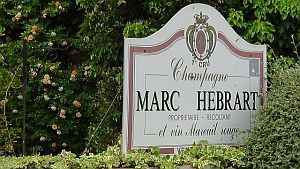 The vines are located in 10 villages, 5 of which are Grand Cru: Avize, Oiry and Chouilly in La Côte des Blancs provide Chardonnay and Aÿ and Louvois provide Pinot Noir.
The vines are located in 10 villages, 5 of which are Grand Cru: Avize, Oiry and Chouilly in La Côte des Blancs provide Chardonnay and Aÿ and Louvois provide Pinot Noir.
The bulk (8.5 hectares) of the family vineyards are in Mareuil-sur-Aÿ and the remainder are in Bisseuil, Avenay Val d’Or, Dizy and Hautvillers. With the possible exception of the last one these are not villages well known for Meunier and it’s not surprising therefore that there is no Meunier in any of the Hébrart blends.
Within the 15 hectares there are 75 separate plots each with its own name and its own history. ‘Le Faubourg d’Enfer’ ( the suburbs of Hell) is on a slope facing directly south and when the summer sun is beating down it’s ‘as hot as hell’ if you have work to do there. ‘Beauregard’ (beautiful view) is another evocative name and I can’t help wondering what the story is behind the intriguingly named ‘Justice- Montaigu’.
One of the world’s top 100 wineries
When Jean-Paul started managing the business exports accounted for only 15% of sales. Today that share has risen to 85%, exceptionally high for a small vigneron. Whilst this is good news for consumers all over the world who at least have a chance of finding the brand in their local market, you’ll be disappointed if you were looking forward to one day meeting him in your country. Jean-Paul doesn’t do any travelling and focuses instead on the work in the vineyards and the winery where he can directly influence the quality of the wines.
There’s an old saying in Champagne - Un bon vin, point d’enseigne – a good wine needs no advertising – and whilst some may disagree, Jean-Paul prefers to leave the promotional part to his network of importers and distributors.
It would seem he’s made another shrewd decision because his commitment to quality is bearing fruit. In 2014 Marc Hébrart was named as one of the 100 leading wineries in the world by Wine & Spirits magazine, one of only 5 champagnes to make it onto the list.
With quality like this and ratings equal to, or just barely below, other more famous brands such as Krug, Champagne Marc Hébrart offers outstanding value, indeed the US importer suggests that at a mere $55 USD per bottle Marc Hébrart Sélection 1er Cru is probably the best value wine in their entire range.
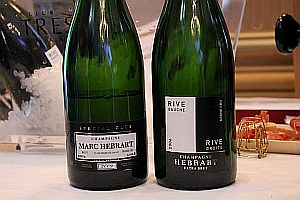 As if more evidence were needed of the quality of these champagnes I could cite the fact that Champagne Marc Hébrart is a member of both the exclusive Club Trésors de Champagne and also of Les Artisans de Champagne, another association whose members all have glowing reputations. However, when all is said and done, the best way is to judge for yourself and when you do I imagine that you will end up agreeing with Jean-Paul that a good wine needs no advertising.
As if more evidence were needed of the quality of these champagnes I could cite the fact that Champagne Marc Hébrart is a member of both the exclusive Club Trésors de Champagne and also of Les Artisans de Champagne, another association whose members all have glowing reputations. However, when all is said and done, the best way is to judge for yourself and when you do I imagine that you will end up agreeing with Jean-Paul that a good wine needs no advertising.
Below are some notes from a tasting during a visit on May 25th and you’ll find a list of the champagnes tasted on the two sheets at the end of the article. First a few background facts:
- Jean-Paul is not a huge fan of low dosage which he feels can sometimes shorten the finish. Most of his champagnes are Brut and dosé at around 7.5 g/l the exception Rive Gauche-Rive Droite which is Extra Brut
- Only MCR (concentrated grape juice)is used for the liqueur de dosage because of is neutral quality, even though it is many times more expensive than cane sugar which is more commonly used.
- Malo-lactic fermentation is not carried out.
- Rive Gauche-Rive Droite is the only cuvée currently sold that is partially aged in oak barrels, although the reserve wines – usually going back 4 years - also spend some time in oak.
- Two new cuvées are in the wings ( or rather, cellars) waiting to be launched in the not too distant future: a Blanc de Noirs and a single vineyard champagne from Dizy.
---
Tasting Notes
Blanc de Blancs Brut 1er Cru
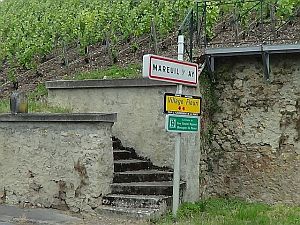 Most of the Chardonnay in this blend comes not, as you might assume, from la Côte des Blancs, but from the Hébrart vineyards in the more Pinot friendly village of Marueil-sur-Aÿ. As a result this is a wonderfully smooth champagne that sits effortlessly on the tongue. Yes, it has plenty of the freshness expected of a Blanc de Blancs and a light floral bouquet, but it also has a weight and a delightful presence in the mouth.
Most of the Chardonnay in this blend comes not, as you might assume, from la Côte des Blancs, but from the Hébrart vineyards in the more Pinot friendly village of Marueil-sur-Aÿ. As a result this is a wonderfully smooth champagne that sits effortlessly on the tongue. Yes, it has plenty of the freshness expected of a Blanc de Blancs and a light floral bouquet, but it also has a weight and a delightful presence in the mouth.
Selection 1er Cru
Long and seamless,
Disgorged in early 2015 after nearly 4 years on lees.
The base year is 2010 which was a difficult year plagued with rot to the extent that Jean-paul discarded 30% of his crop in order to maintain the quality of his wines
Rosé Brut 1er Cru
Rosé accounts for 20% of Jean-Paul’s sales: a high percentage even allowing for the continuing popularity of rosé wines of all types , but when you taste this rosé you can understand its poularity. It reminded me of a type of ice cream I used to buy when I was younger – much younger . It was called a Mivvie if you can remember that. A cool, crisp layer of intense strawberry ice on the outside and a creamy vanilla filling I never thought I’d find that wonderful combination again in a champagne.
Special Club 1er Cru 2010
55% Pinot Noir from Mareuil-sur-Aÿ and 45% Chardonnay from Oiry and Chouilly.
The blend is almost exactly the same from year to year because, as Jean-Paul says “ Old vines don’t move from one year to the next and the best plots always produce the best grapes”
Rive Gauche-Rive Droite ( Left Bank-Right Bank)
The jewel in the crown. First released in 2004 and produced in limited quantities of just 3500 bottles. Not released every year.
A 50/50 blend of Chardonnay from La Côte des Blancs on the far (left) side of the river Marne and Pinot Noir from Aÿ on the right side of the river.
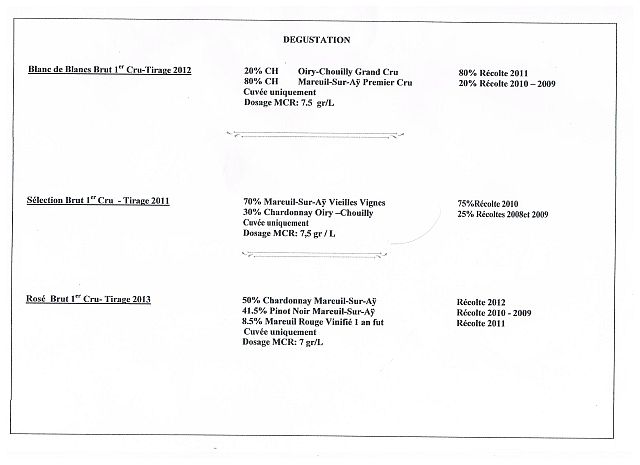
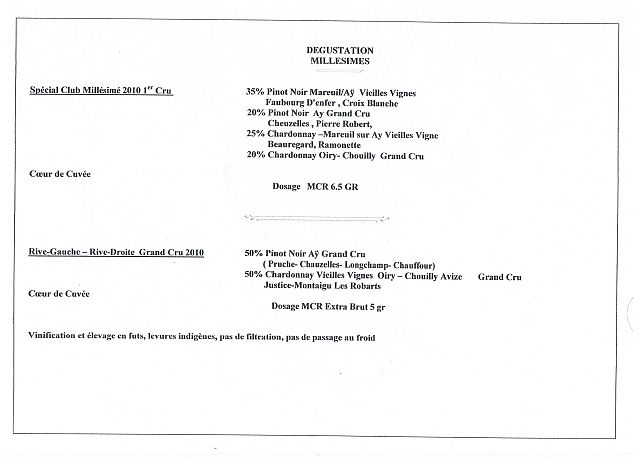


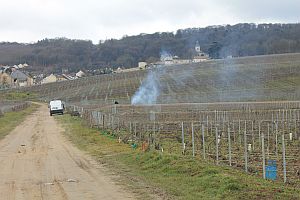 At this time of year a sort of rash appears in the champagne vineyards – a rash of white vans dotted all over the slopes as the vignerons hurry to finish pruning their vines before they really start growing again after their winter rest.
At this time of year a sort of rash appears in the champagne vineyards – a rash of white vans dotted all over the slopes as the vignerons hurry to finish pruning their vines before they really start growing again after their winter rest.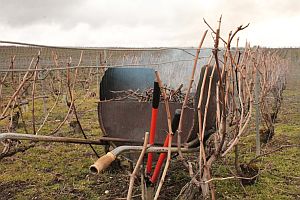
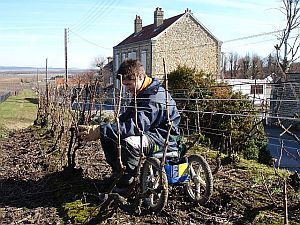 Out come the white vans, the little rolling stools on which the workers sit as they work their way down the rows carefully pruning each and every plant, and the rusty old wheelbarrows in which the off-cuts are burned leaving tell-tale wisps of white smoke drifting across the rather barren looking vineyards (actually, ‘wheelbarrow ‘is rather a flattering term for these ‘brouettes’ which are little more than steel drums cut in two and fixed on a set of wheels).
Out come the white vans, the little rolling stools on which the workers sit as they work their way down the rows carefully pruning each and every plant, and the rusty old wheelbarrows in which the off-cuts are burned leaving tell-tale wisps of white smoke drifting across the rather barren looking vineyards (actually, ‘wheelbarrow ‘is rather a flattering term for these ‘brouettes’ which are little more than steel drums cut in two and fixed on a set of wheels).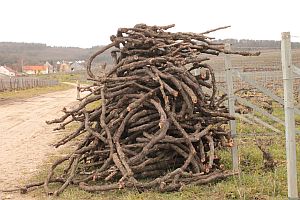 However where there is tradition and habit, entrepreneurial people can always find a new opportunity. A few years ago a young man by the name of Alexandre Hénin was struck not only by the tremendous waste of wood, but also by an idea for a new business: one for which the raw material would be free.
However where there is tradition and habit, entrepreneurial people can always find a new opportunity. A few years ago a young man by the name of Alexandre Hénin was struck not only by the tremendous waste of wood, but also by an idea for a new business: one for which the raw material would be free.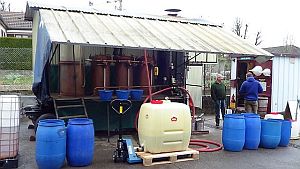 There are very few itinerant distillers left in Champagne these days - very few in the whole of France for that matter - but today I was lucky enough to meet one in the village of Damery.
There are very few itinerant distillers left in Champagne these days - very few in the whole of France for that matter - but today I was lucky enough to meet one in the village of Damery.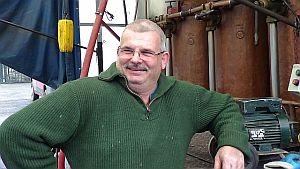 then, for a fee, turns it into alcohol which is returned to the wine maker who can then use it to make Ratafia ( grape juice fortified with alcohol to produce a sweet aperitif drink of about the same strength as sherry).
then, for a fee, turns it into alcohol which is returned to the wine maker who can then use it to make Ratafia ( grape juice fortified with alcohol to produce a sweet aperitif drink of about the same strength as sherry).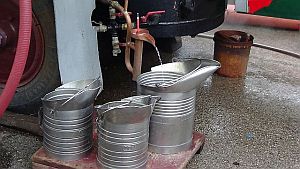
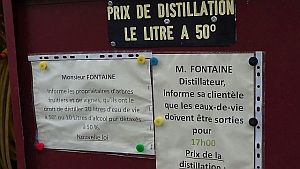
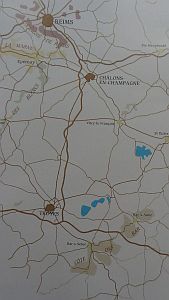 You may not have heard either name and it’s true that the region is much less famous than the more northerly parts of Champagne around Reims and Epernay, yet slowly but surely people who appreciate great champagne are sitting up and taking notice of what’s happening in the south and its reputation is growing fast - a new dawn is certainly breaking.
You may not have heard either name and it’s true that the region is much less famous than the more northerly parts of Champagne around Reims and Epernay, yet slowly but surely people who appreciate great champagne are sitting up and taking notice of what’s happening in the south and its reputation is growing fast - a new dawn is certainly breaking.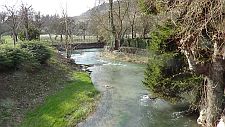 La Côte des Bar, (as the Aube is also called) has two constituent parts: west and east , situated on the slopes overlooking the two main rivers of the region, the Seine and the Aube, and their many tributaries. The western part is La Barséquanais centered on the town of Bar-sur-Seine and the eastern part is La Bar-sur-Aubois centered on the town of Bar-sur-Aube. (see map below)
La Côte des Bar, (as the Aube is also called) has two constituent parts: west and east , situated on the slopes overlooking the two main rivers of the region, the Seine and the Aube, and their many tributaries. The western part is La Barséquanais centered on the town of Bar-sur-Seine and the eastern part is La Bar-sur-Aubois centered on the town of Bar-sur-Aube. (see map below)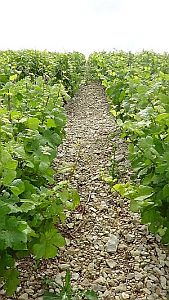 Rivers are an ever present feature of the landscape in the Aube which is criss-crossed with vales and valleys at many angles. The slopes are not steep however and this allows excellent exposure to the sunshine which is slightly more abundant than in the north of Champagne and surely contributes to the quality of the wines. Yet the climate is not always mild, indeed La Côte des Bar seems to have more than its fair share of extreme weather conditions, both hot and cold. This, together with the soil which in some places is extremely stony and difficult to till, means that it can be a struggle growing vines and making champagne here, but as some of the local vignerons will tell you with a wry smile “you sometimes have to suffer to make something of beauty”.
Rivers are an ever present feature of the landscape in the Aube which is criss-crossed with vales and valleys at many angles. The slopes are not steep however and this allows excellent exposure to the sunshine which is slightly more abundant than in the north of Champagne and surely contributes to the quality of the wines. Yet the climate is not always mild, indeed La Côte des Bar seems to have more than its fair share of extreme weather conditions, both hot and cold. This, together with the soil which in some places is extremely stony and difficult to till, means that it can be a struggle growing vines and making champagne here, but as some of the local vignerons will tell you with a wry smile “you sometimes have to suffer to make something of beauty”.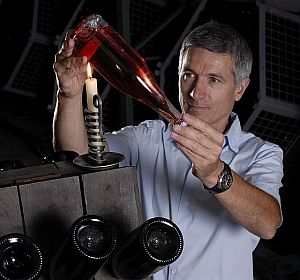 Rémy Massin
Rémy Massin Olivier Horiot
Olivier Horiot